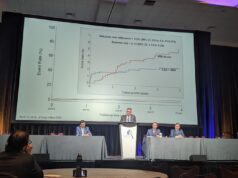 Data from the US Vascular Quality Initiative (VQI) have indicated that younger patients (aged ≤55 years) who undergo a carotid endarterectomy (CEA) procedure face an increased likelihood of carotid disease recurrence and late neurological events, as compared to their older counterparts. These findings have been published in the Journal of Vascular Surgery (JVS) by Caron Rockman (New York University Langone Medical Center, New York, USA) and colleagues.
Data from the US Vascular Quality Initiative (VQI) have indicated that younger patients (aged ≤55 years) who undergo a carotid endarterectomy (CEA) procedure face an increased likelihood of carotid disease recurrence and late neurological events, as compared to their older counterparts. These findings have been published in the Journal of Vascular Surgery (JVS) by Caron Rockman (New York University Langone Medical Center, New York, USA) and colleagues.
“These data suggest that younger CEA patients may require more diligent follow-up, as well as a continued aggressive approach to medical management of atherosclerosis to prevent future events related to the operated artery, given the particularly aggressive nature of premature atherosclerosis,” the authors write.
They posit at the outset of their report that there are “few data” regarding outcomes of patients with premature cerebrovascular disease—those aged ≤55 years—who undergo CEA, and this led them to conduct a study analysing the demographics, presentation, and perioperative and later outcomes of younger patients receiving this treatment.
Querying the Society for Vascular Surgery (SVS) VQI for CEA cases between 2012 and 2022, and stratifying patients based on age, Rockman and colleagues found that 7,009 of the 120,549 patients undergoing CEA (5.5%) were ≤55 years old. Their analysis revealed that younger patients were more likely to be African American (7.7% vs 4.5%), female (45.2% vs 38.9%), and active smokers (57.3% vs 24.1%).
As per their prespecified primary endpoints, the authors note similar rates of perioperative stroke/death (2% in both groups) and postoperative neurological events (1.9% vs 1.8%) across younger and older patients. Reintervention rates did not significantly differ between the two cohorts either.
However, younger patients were also found to have lower rates of overall postoperative complications versus their older counterparts (3.7% vs 4.7%)—as well as being “significantly more likely” to experience late failure, defined as significant restenosis (≥80%) or complete occlusion of the operated artery (2.4% vs 1.5%). Furthermore, younger patients were observed as being more likely to experience a neurological event of any kind (3.1% vs 2.3%).
“After controlling for covariates using a logistic regression model, [being aged] 55 years or younger was independently associated with increased odds of late restenosis or occlusion […] as well as late neurological events […],” Rockman and colleagues add.
In addition to highlighting the fact that younger patients appear to be more likely to present symptomatically and undergo non-elective CEA, as compared to older patients, the authors conclude their JVS report by stating that younger patients are more likely to experience carotid occlusion or restenosis as well as subsequent neurological events “during a relatively short follow-up period”—despite similar perioperative outcomes between the two groups.










